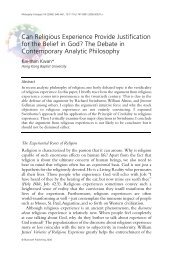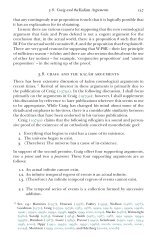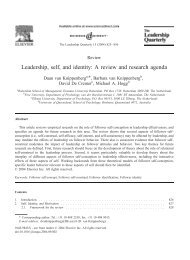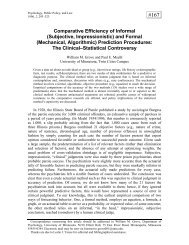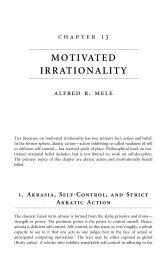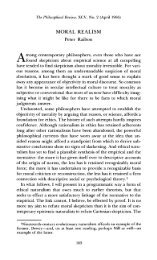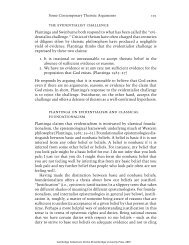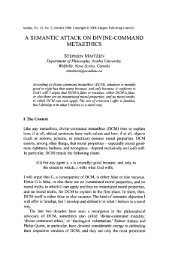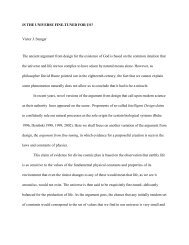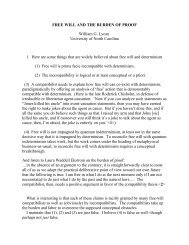The Problem of Evil - Common Sense Atheism
The Problem of Evil - Common Sense Atheism
The Problem of Evil - Common Sense Atheism
Create successful ePaper yourself
Turn your PDF publications into a flip-book with our unique Google optimized e-Paper software.
<strong>The</strong> Local Argument from <strong>Evil</strong> 99<br />
<strong>The</strong>re has been, in the history <strong>of</strong> the world, at least one horror such<br />
that, if it had not existed, if it had been, so to speak, simply left out <strong>of</strong><br />
the world, the world would be no worse than it is.<br />
If this generalization is true, then, even if (1) is false, there has been<br />
at least one horror in the history <strong>of</strong> the world that Atheist could use<br />
to show that the world was not created by an omnipotent and morally<br />
perfect being—given, <strong>of</strong> course, that the other three premises <strong>of</strong> her<br />
argument, suitably adjusted, are true.<br />
I am going to represent <strong>The</strong>ist as employing another line <strong>of</strong> attack<br />
on Atheist’s response to his expanded free-will defense. I am going to<br />
represent him as denying premise (3) or, more precisely, as trying to<br />
show that the expanded free-will defense casts considerable doubt on<br />
premise (3). In order to enable you the better to follow what <strong>The</strong>ist<br />
says, I will attempt to fix the essential content <strong>of</strong> premise (3) in your<br />
minds by restating it in terms <strong>of</strong> a rather fanciful metaphor. Consider a<br />
morally perfect creator who is taking a final look at the four-dimensional<br />
blueprint <strong>of</strong> the world he is about to create. His eye falls on a patch in<br />
the blueprint that represents a horror. He reflects a moment and sees<br />
that if he simply erases that patch, replaces it with something innocuous,<br />
and does a little smoothing around the spatiotemporal edges to render<br />
the lines <strong>of</strong> causation in the revised blueprint continuous (or nearly so),<br />
a world made according to the revised blueprint will contain at least<br />
as favorable a balance <strong>of</strong> good and evil as a world made according to<br />
the unrevised blueprint. He therefore perceives a moral obligation to<br />
revise the blueprint in the way he has thought <strong>of</strong> and to incorporate the<br />
revision into his creation, and, being morally perfect, necessarily revises<br />
and creates accordingly. (Or, to be pedantic, he necessarily so revises and<br />
so creates if he is able so to revise and so to create.) Premise (3) simply<br />
says that this is what must happen when a morally perfect creator<br />
perceives in his plan for the world a horror that can be ‘‘edited out’’<br />
without significantly altering the balance <strong>of</strong> good and evil represented<br />
in that plan.<br />
Now that we have, I hope, got the content <strong>of</strong> premise (3) into our<br />
minds in an intuitive and memorable form, we are ready to hear <strong>The</strong>ist’s<br />
reply to Atheist’s rejoinder to the expanded free-will defense:<br />
Why should we accept this premise? I have had a look at Rowe’s defense<br />
<strong>of</strong> the corresponding premise <strong>of</strong> his argument, the entirety <strong>of</strong> which I<br />
will quote:



